
Malpighia emarginata is a tropical fruit-bearing shrub or small tree in the family Malpighiaceae.

The papaya, papaw, or pawpaw is the plant species Carica papaya, one of the 21 accepted species in the genus Carica of the family Caricaceae, and also the name of its fruit. It was first domesticated in Mesoamerica, within modern-day southern Mexico and Central America. It is grown in several countries in regions with a tropical climate. In 2022, India produced 38% of the world's supply of papayas.

Guava is a common tropical fruit cultivated in many tropical and subtropical regions. The common guava Psidium guajava is a small tree in the myrtle family (Myrtaceae), native to Mexico, Central America, the Caribbean and northern South America. The name guava is also given to some other species in the genus Psidium such as strawberry guava and to the pineapple guava, Feijoa sellowiana. In 2019, 55 million tonnes of guavas were produced worldwide, led by India with 45% of the total. Botanically, guavas are berries.

Passiflora, known also as the passion flowers or passion vines, is a genus of about 550 species of flowering plants, the type genus of the family Passifloraceae.

Prunus spinosa, called blackthorn or sloe, is a species of flowering plant in the rose family Rosaceae. The species is native to Europe, western Asia, and regionally in northwest Africa. It is locally naturalized in New Zealand, Tasmania, and the Pacific Northwest and New England regions of the United States.

Arctostaphylos uva-ursi is a plant species of the genus Arctostaphylos widely distributed across circumboreal regions of the subarctic Northern Hemisphere. Kinnikinnick is a common name in Canada and the United States. Growing up to 30 centimetres in height, the leaves are evergreen. The flowers are white to pink and the fruit is a red berry.

Melia azedarach, commonly known as the chinaberry tree, pride of India, bead-tree, Cape lilac, syringa berrytree, Persian lilac, Indian lilac, or white cedar, is a species of deciduous tree in the mahogany family, Meliaceae, that is native to Indomalaya and Australasia.

Annona squamosa is a small, well-branched tree or shrub from the family Annonaceae that bears edible fruits called sugar apples or sweetsops. It tolerates a tropical lowland climate better than its relatives Annona reticulata and Annona cherimola helping make it the most widely cultivated of these species. Annona squamosa is a small, semi-(or late) deciduous, much-branched shrub or small tree 3 to 8 metres tall similar to soursop. It is a native of tropical climate in the Americas and West Indies, and Spanish traders aboard the Manila galleons docking in the Philippines brought it to Asia.
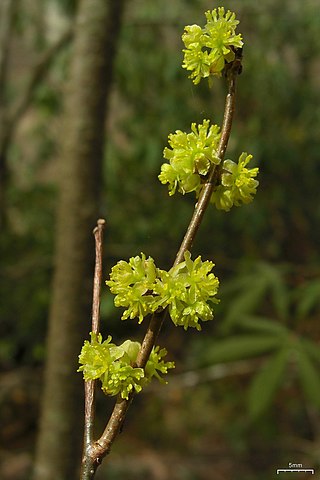
Lindera benzoin is a shrub in the laurel family. It is native to eastern North America, ranging from Maine and New York to Ontario in the north, and to Kansas, Texas, and northern Florida in the center and south. Within its native range it is a relatively common plant where it grows in the understory in moist, rich woods, especially those with exposed limestone.
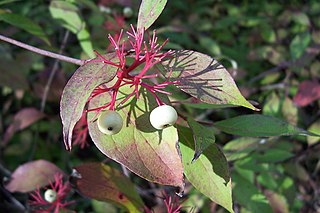
Cornus sericea, the red osier or red-osier dogwood, is a species of flowering plant in the family Cornaceae, native to much of North America. It has sometimes been considered a synonym of the Asian species Cornus alba. Other names include red brush, red willow, redstem dogwood, redtwig dogwood, red-rood, American dogwood, creek dogwood, and western dogwood.
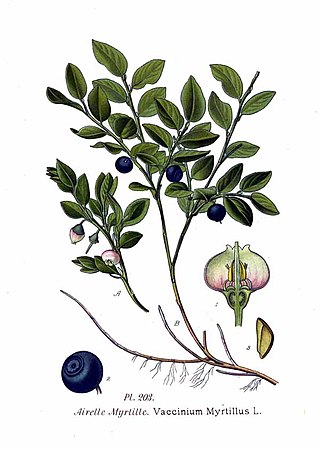
Vaccinium myrtillus or European blueberry is a holarctic species of shrub with edible fruit of blue color, known by the common names bilberry, blaeberry, wimberry, and whortleberry. It is more precisely called common bilberry or blue whortleberry to distinguish it from other Vaccinium relatives.

Spondias mombin, also known as yellow mombin, hog plum, amra or cajazeira, is a species of tree and flowering plant in the family Anacardiaceae. It is native to the tropical Americas, including the West Indies. The tree was introduced by the Portuguese in South Asia in the beginning of the 17th century. It has been naturalized in parts of Africa, India, Nepal, Bangladesh, Sri Lanka, The Bahamas, Indonesia, and other Caribbean islands. It is rarely cultivated except in parts of the Brazilian Northeast.

Berberis trifoliolata is a species of flowering plant in the family Berberidaceae, in southwestern North America. Common names include agarita, agrito, algerita, currant-of-Texas, wild currant, and chaparral berry. The name Agarita comes from the Spanish verb agarrar, which means "to grab". The ending "-ita" is often added to little things, so agarita means "grabs a little". This was probably said because the bush is a bit scratchy but does not have significant spines. Typical characteristics are grey-green to blue-grey leaves, yellow flowers in February to April and the red berries appearing in May. The most important harvest organ are the berries, though the roots and seeds can also be used.

Punica protopunica, commonly known as the pomegranate tree or Socotran pomegranate, is a species of flowering plant in the family Lythraceae. It is endemic to the island of Socotra (Yemen). Its natural habitat is subtropical or tropical dry forests.
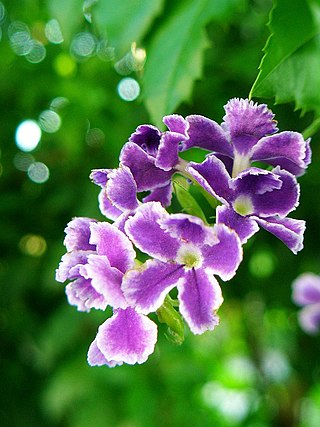
Duranta is a genus of flowering plants in the verbena family, Verbenaceae. It contains 17 species of shrubs and small trees that are native from southern Florida to Mexico and South America. They are commonly cultivated as hedges and ornamental plants.
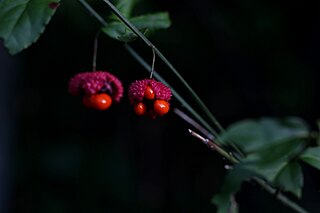
Euonymus americanus is a species of flowering plant in the family Celastraceae. Common names include strawberry bush, American strawberry bush, bursting-heart, hearts-a-bustin, and hearts-bustin'-with-love. It is native to the eastern United States, its distribution extending as far west as Texas. It has also been recorded in Ontario.

Annona senegalensis, commonly known as African custard-apple, wild custard apple, wild soursop, abo ibobo, sunkungo, and dorgot is a species of flowering plant in the custard apple family, Annonaceae. The specific epithet, senegalensis, translates to mean "of Senegal", the country where the type specimen was collected.

Duranta erecta is a species of flowering shrub in the verbena family Verbenaceae, native from Mexico to South America and the Caribbean. It is widely cultivated as an ornamental plant in tropical and subtropical gardens throughout the world, and has become naturalized in many places. Common names include golden dewdrop, pigeon berry, and skyflower.
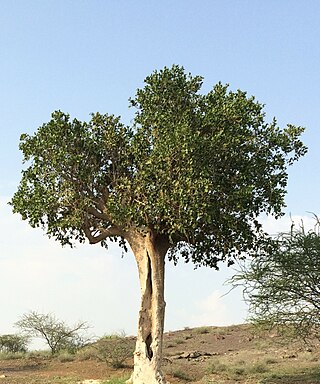
Dobera glabra is an evergreen shrub or tree native to the Somali peninsula, Northeastern Kenya and Ethiopia as well as South Tihamah. In Somali speaking regions, it is widely known as Garas. In Ethiopia, you will find it in Nechisar National Park and along the Sagan River in the Konso special woreda. It is also sparsely distributed in Afar Region where the tree is much known for its fruits. It is known to grow up to 10 metres (0.0062 mi) in height.

Deinbollia oblongifolia is a shrub or small tree in the family Sapindaceae. It is commonly known as the dune soap-berry and is found in coastal vegetation from the Eastern Cape of South Africa, through KwaZulu-Natal to southern Mozambique and Eswatini. It is named after Peter Vogelius Deinboll (1783–1876), a Danish botanist and plant collector.





















